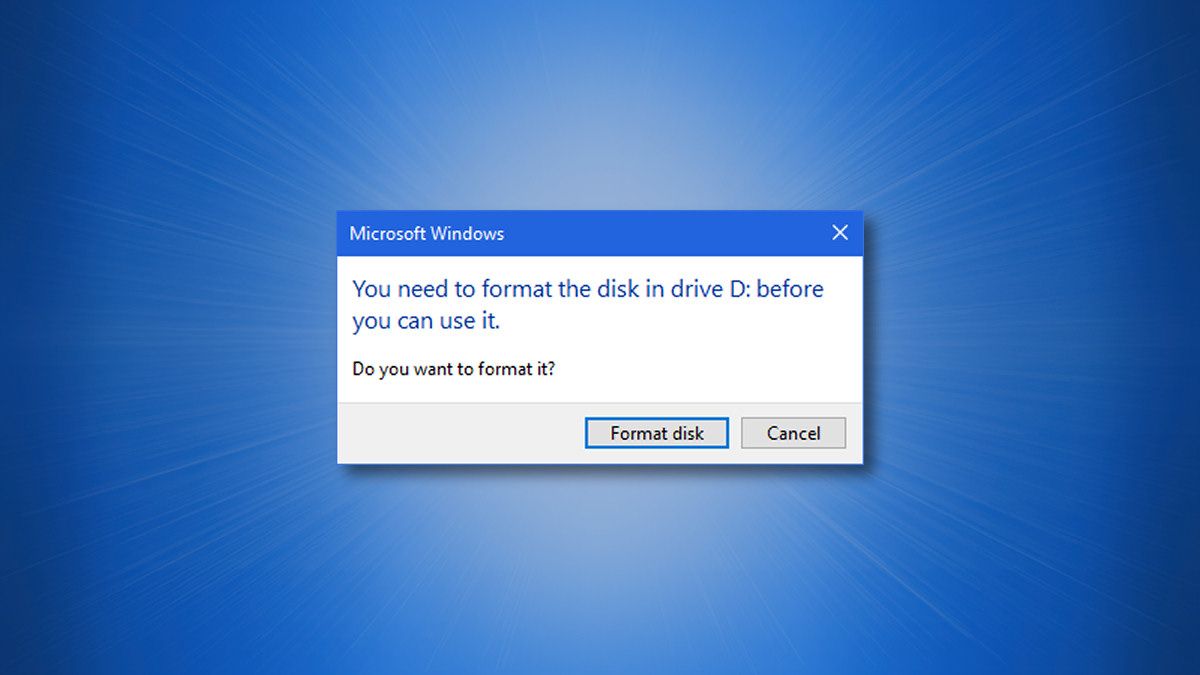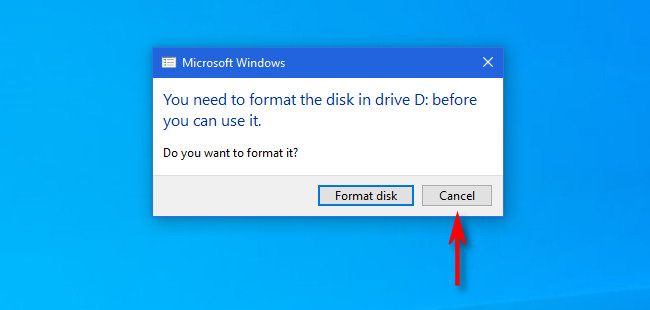Quick Links
Have you ever plugged a native Mac drive into a Windows 10 PC? If you do, you'll see a scary-looking message asking you to format the disk. Why does Windows do that? We'll explain.
Windows Can't Read Mac File Systems
Here's the brief technical answer for the scary prompt: Mac-formatted drives use a file system that Windows 10 can't read, and Windows wants you to reformat the Mac drive with a file system that Windows can understand. Unfortunately, formatting will also erase all of the data on the disk, so don't hit the "Format Disk" button just yet.
There are other options, but first, let's take a deeper look at what's going on.
A Tale of Two File Systems
By default, Windows 10 and Macintosh computers use two different file systems. A file system is a software method that determines how an operating system writes data to (and reads data from) a storage medium such as a hard disk or a USB drive.
Windows 10 uses the NTFS file system, and macOS currently uses APFS. (macOS previously used HFS+ in macOS 10.12 and earlier.) If you format a drive as APFS on a Mac, Windows 10 won't read it, because APFS is a proprietary file system format created by Apple.
For example, if you insert a USB drive formatted as APFS or HFS+ into a Windows 10 PC, you'll see a warning pop-up that reads "You need to format the disk in drive [letter] before you can use it. Do you want to format it?" When you see this message while attempting to read a known good disk, always click "Cancel."
If you click "Format Disk" and go through with the formatting process, you'll lose all of the data on the disk! And Microsoft doesn't mind, apparently.
So Why Does Windows Really Do That?
If Microsoft really wanted, Windows could attempt to read your Mac-formatted drives. It could perhaps license the APFS technology from Apple and include it with Windows 10---or, at the very least, alert you that you've inserted a Mac-formatted drive and explain why it can't be read.
Instead, Windows 10 pretends that your Mac disk is equivalent to a corrupt or unformatted disk and doesn't mind if you accidentally format it and lose all of your data. "Not my problem!", says Windows. The same goes for Linux-formatted drives, and it's a common frustration for multi-platform computer users.
The reason for Microsoft's user-hostile behavior in this particular case is tradition. Windows has long been the dominant desktop computer platform, and it can get away with treating foreign file systems like they don't exist.
In contrast, macOS can read NTFS-formatted drives (but cannot write to them without add-on software), and it can also read and write the FAT32 legacy Windows file system and Microsoft's exFAT in a nod to compatibility of removable drives between vendors.
Is There Any Way Around It?
If you have data on a Mac disk that you need to transfer to a Windows 10 PC, there are some ways to get around the issue. Here are a few of them.
- Transfer the Data Through a Network: You can avoid a Mac-formatted disk entirely and share files over a LAN, send them through a cloud-based backup service like Dropbox, or even email a few files to yourself as attachments.
- Install a Third-Party Tool: Some third-party vendors make utilities that allow you to read Mac-formatted drives on Windows. Linux Reader by DiskInternals is a freeware tool that reads APFS drives but won't write them. APFS for Windows by Paragon is a commercial product ($50) that lets you read and write APFS drives. For HFS+ drives, you can install HFSExplorer, a free utility that reads older Mac-formatted drives.
- Make a Drive That Can Be Read on Macs and PCs: If you still have the Mac that wrote the disk available (and room to back up the data on the disk), you could reformat your Mac disk with exFAT file system---which will erase the drive, so back it up first---and then copy the files back onto the drive. Windows and macOS both fully support reading and writing exFAT drives, since it's an industry-standard file system for removable flash media.
If you ask us, it's past time for Windows to treat other file systems with the respect that they deserve. We live in a vibrant multi-platform world these days, and Microsoft's products should reflect that reality. If anything, Microsoft's recent embrace of Linux sets a good example of how to move forward. In the meantime, resist the urge to reformat, and good luck!


